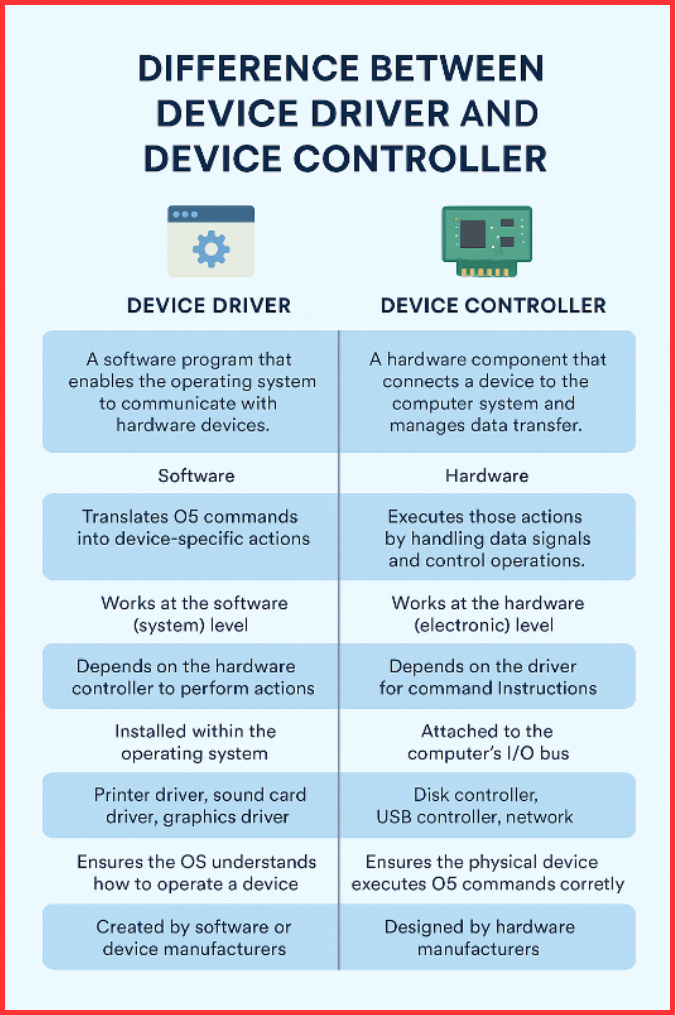The Difference Between Device Driver and Device Controller lies in their nature and role within a computer system. A device driver is a software program that enables the operating system (OS) to communicate with hardware devices, whereas a device controller is a hardware component that connects the physical device to the computer system. Although both terms are often used together, they serve distinct purposes and operate at different layers of the system.
Let’s explore both concepts in detail.
What is a Device Driver?
A device driver is a specialized software component that allows the operating system to control and interact with a particular hardware device. It acts as a translator between the OS and the hardware, ensuring that commands from the OS are properly executed by the device.
For example, when you print a document, the printer driver converts the operating system’s commands into instructions the printer can understand. Without this driver, the OS wouldn’t be able to communicate with the printer effectively.
Device drivers come pre-installed with the operating system or are provided by the hardware manufacturer. They are essential for managing hardware like sound cards, graphic cards, keyboards, storage devices, and more.
In short, device drivers make sure your computer’s hardware and software work seamlessly together.
What is a Device Controller?
A device controller is a hardware unit that acts as an interface between a device and the computer system. It connects to the I/O (Input/Output) bus of the computer and manages the data flow between the CPU and the peripheral device.
The controller consists of electronic chips that handle commands like read, write, and other operations sent from the OS through the device driver. It temporarily stores the data received from the connected device and sends it to the driver for further processing.
Each hardware device—such as a hard drive, network adapter, or display—has its own device controller that interprets and executes commands from the OS via its corresponding driver. Essentially, the controller manages the electrical and data-level communication, while the driver handles the logical communication.
Difference Between Device Driver and Device Controller
| Aspect | Device Driver | Device Controller |
| Definition | A software program that enables the operating system to communicate with hardware devices. | A hardware component that connects a device to the computer system and manages data transfer. |
| Nature | Software | Hardware |
| Function | Translates OS commands into device-specific actions. | Executes those actions by handling data signals and control operations. |
| Layer of Operation | Works at the software (system) level. | Works at the hardware (electronic) level. |
| Dependency | Depends on the hardware controller to perform actions. | Depends on the driver for command instructions. |
| Location | Installed within the operating system. | Attached to the computer’s I/O bus. |
| Examples | Printer driver, sound card driver, graphics driver. | Disk controller, USB controller, network controller. |
| Purpose | Ensures the OS understands how to operate a device. | Ensures the physical device executes OS commands correctly. |
| Developer | Created by software or device manufacturers. | Designed by hardware manufacturers. |
| Communication Bridge | Between OS and device controller. | Between device driver and the physical device. |

Significance of Device Driver and Device Controller
Both the device driver and device controller are essential for hardware communication in computing systems. The device driver ensures the OS understands the hardware’s functionality, while the device controller ensures the hardware physically responds to those commands. Together, they form a bridge that allows smooth data transfer and coordination between software and hardware components.
Summary
To summarize, the Difference Between Device Driver and Device Controller is that a device driver is a software interface that manages communication between the operating system and hardware, while a device controller is a hardware interface that manages signal and data transfer between the device and the system.
In simpler terms, the driver tells the device what to do, and the controller executes those instructions. Both are crucial for the smooth operation of any computer system.